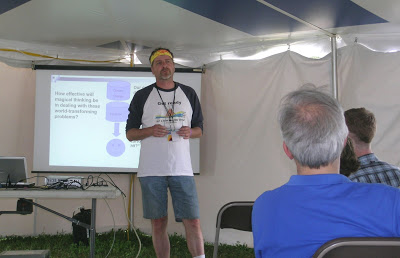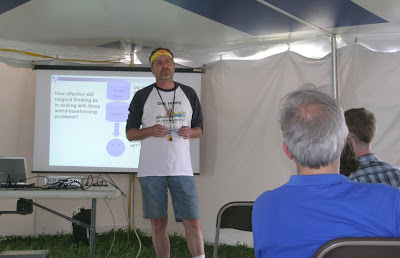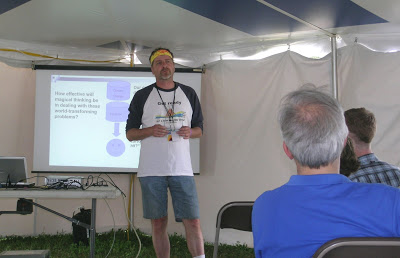by jboullion | Oct 16, 2009 | Uncategorized
From an article by Larry Bivins in the Marshfield News Herald:
WASHINGTON — As a member of the U.S. Army’s 1st Armored Division’s main support battalion in 2003, Robin Eckstein hauled fuel and water for the military in Iraq.
Through that experience, she said, she began to think about how dangerously dependent America was on foreign oil and the need for an alternative energy source.
“I ran missions every day, if not twice a day,” Eckstein said. “It was just apparent that having only one source of energy to refuel our trucks was a problem because it meant more runs, and that meant more risks.”
For Eckstein, a policy addressing clean energy and climate change became a national security issue, just as it has for scores of other current and former military personnel. But that’s not the only reason the 32-year-old Appleton native is on the road in support of energy policy legislation Congress is considering.
Eckstein also is jobless and says she believes the bill the House has passed and a Senate bill would create jobs.
“We have the manufacturing base in Wisconsin,” she said, “where I think we could really use these clean-energy jobs.”
Last weekend, Eckstein was in Washington to help make a commercial for Operation FREE, a coalition of veterans and national security organizations, on climate change and national security.

by jboullion | Jun 24, 2009 | Uncategorized

From a presentation by RENEW’s Michael Vickerman (above) at the Energy Fair of the Midwest Renewable Energy Association:
Energy Policy Must Recognize Energy Realities
+ Supplies of liquid fuels peaked in 2008
+ Capital is disappearing before our very eyes
+ Energy and food are the original currencies
+ The shift from stores to flows is inevitable
+ Current economy is highly energy-intensive
+ Energy return on energy invested (EROEI) must inform decision-making
+ We can’t afford to prop up existing energy sinks or engage in wealth-draining military adventures
Three paths to choose
+ Business as usual
+ Clean green technology
+ Curtailment and community

by jboullion | Jun 24, 2009 | Uncategorized

From a presentation by RENEW’s Michael Vickerman (above) at the Energy Fair of the Midwest Renewable Energy Association:
Energy Policy Must Recognize Energy Realities
+ Supplies of liquid fuels peaked in 2008
+ Capital is disappearing before our very eyes
+ Energy and food are the original currencies
+ The shift from stores to flows is inevitable
+ Current economy is highly energy-intensive
+ Energy return on energy invested (EROEI) must inform decision-making
+ We can’t afford to prop up existing energy sinks or engage in wealth-draining military adventures
Three paths to choose
+ Business as usual
+ Clean green technology
+ Curtailment and community

by jboullion | Jun 24, 2009 | Uncategorized

From a presentation by RENEW’s Michael Vickerman (above) at the Energy Fair of the Midwest Renewable Energy Association:
Energy Policy Must Recognize Energy Realities
+ Supplies of liquid fuels peaked in 2008
+ Capital is disappearing before our very eyes
+ Energy and food are the original currencies
+ The shift from stores to flows is inevitable
+ Current economy is highly energy-intensive
+ Energy return on energy invested (EROEI) must inform decision-making
+ We can’t afford to prop up existing energy sinks or engage in wealth-draining military adventures
Three paths to choose
+ Business as usual
+ Clean green technology
+ Curtailment and community
by jboullion | May 21, 2009 | Uncategorized
From a news release issued by the Wisconsin Department of Natural Resources:
MADISON – The public is invited to comment on an Environmental Assessment (EA) prepared by the Department of Natural Resources for the Enbridge Alberta Clipper petroleum pipeline system project.
Enbridge Energy Company, Inc., 119 N. 25th Street East, Superior, WI 54880-5247, has applied to DNR for waterway and wetland crossing permits, and air quality permits for the proposed project. The company will also need a stormwater permit and an endangered resources review for the project.
The proposed pipeline project consists of constructing a new 36-inch diameter petroleum pipeline (known as the Alberta Clipper pipeline), a new 20-inch diameter diluent return pipeline (known as the Southern Lights pipeline), an associated pump station for the Southern Lights pipeline, and five 250,000 barrel breakout tanks. The proposed pipelines would be constructed along a 13 mile route in Douglas County from the Wisconsin-Minnesota border to the Enbridge Superior Terminal in Superior, Wisconsin.
The pipelines would be largely constructed in parallel within an existing pipeline right-of-way that includes four other crude oil pipelines. The pump station and the breakout tanks would be constructed at the Enbridge Superior Terminal at Superior.
The purpose of the Alberta Clipper petroleum pipeline and breakout tanks is to bring crude oil from the tar sands area of Alberta, Canada to refineries in the Midwestern U.S. The Southern Lights diluent pipeline and pumping station are intended to return diluent from the Midwestern U.S. refineries to Alberta, Canada. Diluent is similar to gasoline, and is used to thin crude oil so that it can be pumped through pipelines.
The proposed pipelines would require 17 water body crossings, including 10 tributaries to the Pokegama River, three un-named waterways, two tributaries to the Little Pokegama River, one crossing of the Pokegama River, and one crossing of an un-named tributary to the Nemadji River.
The proposed pipelines would temporarily impact approximately 75 acres of wetland. The pump station and breakout tanks at the Superior Terminal would fill approximately 12 acres of wetland, and temporarily impact approximately 3 acres of wetland.
Air emissions directly associated with the proposed pipeline project at the Enbridge terminal in Superior are from the proposed construction and operation of five new external floating roof tanks having capacities of 8.7 million gallons each, and from associated fugitive emissions from pumping and piping on site. The estimated potential emissions from the tanks and associated fugitive sources are 39 tons per year of Volatile Organic Compounds (VOCs). The project will also increase the facility emissions of hazardous air pollutants from crude oil (e.g. benzene, n-hexane). Construction and operation permits from DNR’s air management program will be public noticed separately. . . .
Copies of the environmental assessment that led to the DNR’s preliminary determination can be obtained from Benjamin Callan, Water Management Specialist, at DNR (OE/7), PO Box 7921, Madison, WI 53707-7921, or via E-mail at benjamin.callan@wisconsin.gov.
DNR has scheduled a public informational hearing where individuals can learn more about the proposed project and submit written or oral comments about the EA and any DNR wetland and waterway determinations associated with the project. The public informational hearing will be held on June 4, 2009 at the City of Superior Public Library, Large Meeting Room, 5:30 to 8 p.m.
Public comments on the environmental assessment are welcome and must be submitted to Benjamin Callan no later than 4:30 p.m., June 8, 2009.



